Eco-conscious brands are exploring sustainable ways to do print on demand.
Recognizing How Digital Printing Changes the Printing Industry
The printing industry, long steeped in conventional techniques, is going through a radical change with the advent of digital printing. With its potential to stimulate involvement via individualized web content and to use lasting options, it's clear that digital printing is more than a technological breakthrough; it's a pivotal video game changer.
The Advancement of Digital Printing: A Quick Introduction
Considering that its creation, digital printing has actually gone through considerable changes, continually revolutionizing the printing sector. Its development started with the growth of xerography in the mid-20th century, a procedure which prepared for laser printers. With the arrival of the 90s, digital printing technology started to develop, and the industry observed the intro of direct imaging presses, which removed the requirement for printing plates. As the new millennium unfolded, developments in technology further stimulated the growth of electronic printing, bring about the development of high-speed inkjet printers. These devices used exceptional top quality and speed, forever transforming the landscape of the industry. Today, electronic printing stands as a testament to human technology, continuously evolving to satisfy the ever-changing needs of the contemporary globe.

Unloading the Technology Behind Digital Printing
Exploring the complexities of digital printing modern technology, one experiences a rich tapestry of innovative machinery and facility algorithms. At the heart of this procedure lies an electronic picture, which is processed by software program that divides it right into a grid of dots. These dots are then transformed into an electronic code. This code is translated by the printer, which utilizes it to precisely transfer droplets of ink onto the substratum. The droplets are so tiny and accurate that they develop a photo that is practically tantamount from the original. This detailed system, boosted by advanced software application and high-resolution read this article imaging, has transformed the landscape of the printing sector, leading the way for extraordinary levels of information and precision.

The Benefits of Digital Printing for Services
Comprehending the technology behind digital printing provides a clear picture of its accuracy and information. Digital printing is environmentally friendly, making use of much less ink and creating less waste. The full possibility of electronic printing is recognized when used for personalization and personalization, a subject that will certainly be covered in depth in the next area.
The Function of Digital Printing in Customization and Personalization
While traditional printing approaches battle with customization and personalization, digital printing excels in these locations. It enables the simple alteration of layouts, without the requirement for costly and lengthy plate adjustments (print on demand). This makes it possible for services to tailor items to private clients, meeting particular needs and improving client satisfaction
Digital printing likewise permits variable data printing, where components such as text, graphics, and pictures might be changed from one printed item to the next, without reducing the printing procedure. This is particularly helpful for straight marketing campaigns, where tailored messaging can considerably boost response rates. In this means, electronic printing not only transforms the printing sector click here now yet also transforms the method organizations communicate with their clients.
Analysing the Ecological Influence of Digital Printing
Although digital printing has been lauded for its function in modification and best site customization, it is essential to examine its environmental effect. Digital printing can be much less inefficient than traditional methods, because it operates on a 'print on demand' basis, getting rid of the requirement for huge print runs that can cause excess and waste. In addition, it makes use of fewer chemicals and produces less volatile organic substances (VOCs) contrasted to counter printing. Nonetheless, the power use of electronic printers can be high, resulting in boosted carbon impact. Additionally, using non-recyclable printing elements and the obstacle of e-waste monitoring posture substantial ecological problems. While digital printing has many benefits, its ecological influence should be conscientiously managed.
Final thought
Finally, electronic printing has changed the printing industry, supplying rapid, cost-effective, and high-grade services. It facilitates personalization, enhancing client engagement, and utilizes a lasting print-on-demand model. As this modern technology remains to progress, its influence on service interaction, client satisfaction, and environmental sustainability comes to be increasingly profound. Recognizing these changes is vital for businesses to take advantage of the advantages of electronic printing efficiently.